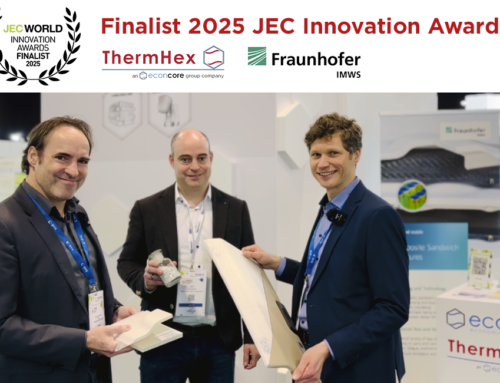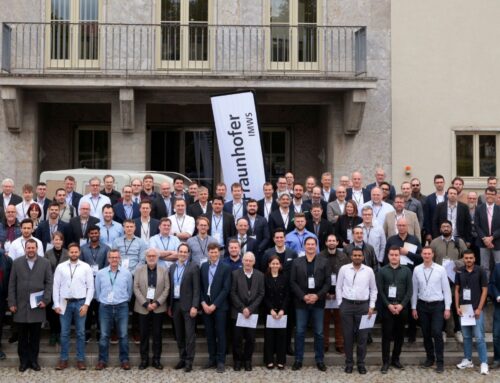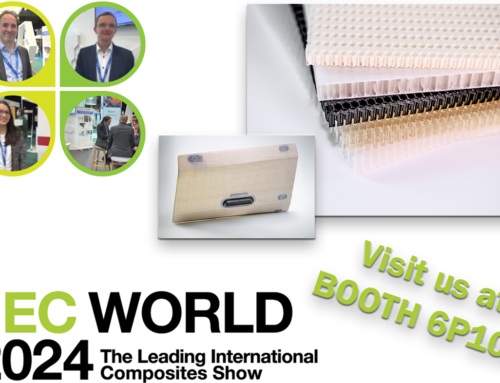Interview in COMPOSITESOLUTIONS & TECHNOPOLYMERS n. 1/2020
ThermHex Waben GmbH has established itself with an innovative honeycomb technology. Customers benefit from considerable cost and weight savings as well as the economical use of resources. We talked to Dr. Jochen Pflug, CEO of ThermHex Waben GmbH, about small revolutions, sustainability, purpose of use and profit for customers.
What attracts you personally to honeycomb cores?
J.P.: “We want honeycomb cores to save costs wherever they reduce weight, and to support our customers in reducing their CO2 footprint while meeting the growing requirements with weight reduction and more efficient use of raw materials. We are firmly convinced that the use of our continuous production technology reduces the costs of lightweight construction materials so that the environmental pollution in many application areas is reduced and the sustainability of the economy is improved”.
At ThermHex, a small revolution is coming off the production line. What is so special about your material?
J.P.: “With the worldwide patented EconCore technology, we are producing thermoplastic honeycomb cores in large volume and very cost-effectively in an automated continuous production process. Until now, honeycomb cores were relatively expensive, complex and had to be pro-duced in many individual steps. They were unable to deliver the combination of cost and weight savings that customers in many industries demand today”.
Can you explain the production process in detail?
J.P.: “In a single production line,thermoplastic polymers are extruded into a film, rotational vacuum-formed and folded into a honeycomb core. In this production line, cover layers can be laminated directly onto the honeycomb with the production of the core. These cover layers can be nonwovens, for the bonding of fiber composite cover layers with duromer resin systems or directly cover layers made of thermoplastic films or fiber reinforced thermoplastic composite materials, aluminum or steel. Our process enables the production of honeycomb cores with a thickness of 3 to 30 mm and a length of 6 m at a speed of up to 10 meters per minute. ThermHex honeycomb cores have a half-closed surface, which enables an optimal connection between core and cover layer. Our honeycomb cores are available in different cell sizes, thicknesses and densities. The integration of the honeycomb production to a continuous production process for a sandwich panel leads to further cost reductions and improved product quality”.
What are ThermHex honeycomb cores used for?
J.P.: “Our honeycomb cores are used as core material in sandwich panels. They keep two cover layers at a distance resulting in an extremely stable and extremely light combination. Lightweight panels with ThermHex honeycomb cores are used for cladding for trucks and coaches, walls for prefabricated bathrooms, su-perstructures for truck trailers, as well as interior for caravan and structural components for vehicles or yachts. Even complex shaped components such as nacelle linings for wind turbines are possible. Due to its low cost, the material is very interesting for cost-sensitive industries such as the packaging, furniture and automotive industries. Due to the combination of cost effective production and best mechanical performance, the honeycomb cores replace monolithic materials which lead to weight savings of up to 80%”.
What key advantages do your customers benefit from?
J.P.: “Due to the continuous production line our customers have maximum cost reduction and maximum weight savings with minimum use of material in one product. The thermoplastic honeycomb cores are also fully recyclable. All residues arising during production are immedi-ately returned to the production cycle”.
Are ThermHex honeycomb cores the ideal product for Industry 4.0?
J.P.: “We are very much involved in Industry 4.0. Since we have a continuous, automated production line, it’s easy to automate the quality control completely and to have complete data from the order to the delivery. Due to the high degree of automation, including automated data pro-cessing, we are completely in line with Industry 4.0”.










